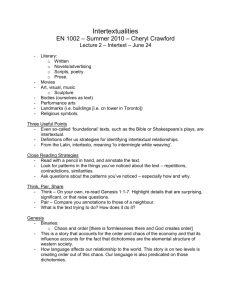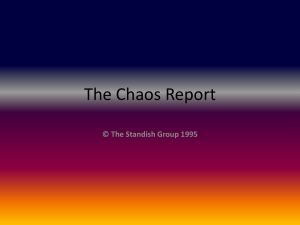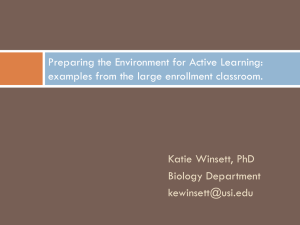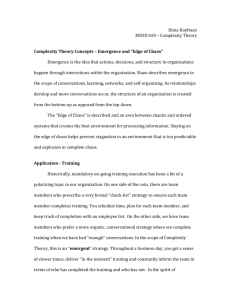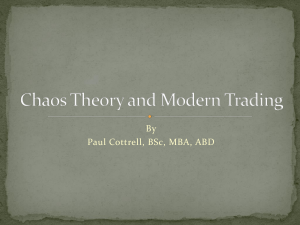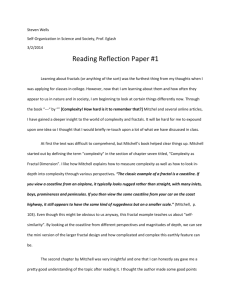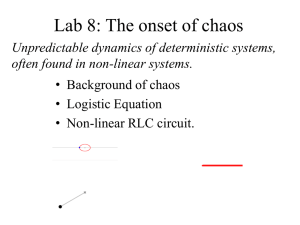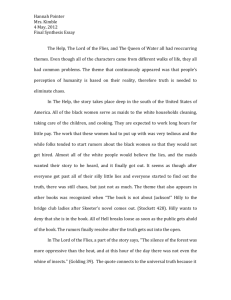Christina Paper 1 Self-Organization and Society
advertisement
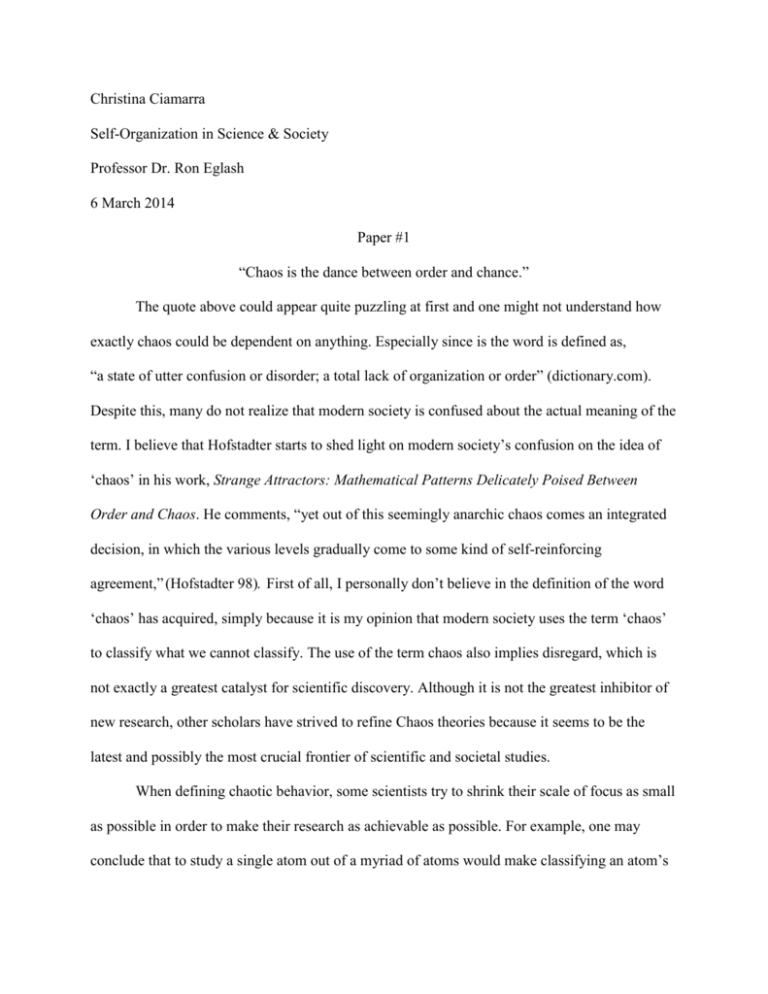
Christina Ciamarra Self-Organization in Science & Society Professor Dr. Ron Eglash 6 March 2014 Paper #1 “Chaos is the dance between order and chance.” The quote above could appear quite puzzling at first and one might not understand how exactly chaos could be dependent on anything. Especially since is the word is defined as, “a state of utter confusion or disorder; a total lack of organization or order” (dictionary.com). Despite this, many do not realize that modern society is confused about the actual meaning of the term. I believe that Hofstadter starts to shed light on modern society’s confusion on the idea of ‘chaos’ in his work, Strange Attractors: Mathematical Patterns Delicately Poised Between Order and Chaos. He comments, “yet out of this seemingly anarchic chaos comes an integrated decision, in which the various levels gradually come to some kind of self-reinforcing agreement,” (Hofstadter 98). First of all, I personally don’t believe in the definition of the word ‘chaos’ has acquired, simply because it is my opinion that modern society uses the term ‘chaos’ to classify what we cannot classify. The use of the term chaos also implies disregard, which is not exactly a greatest catalyst for scientific discovery. Although it is not the greatest inhibitor of new research, other scholars have strived to refine Chaos theories because it seems to be the latest and possibly the most crucial frontier of scientific and societal studies. When defining chaotic behavior, some scientists try to shrink their scale of focus as small as possible in order to make their research as achievable as possible. For example, one may conclude that to study a single atom out of a myriad of atoms would make classifying an atom’s behavior simpler, since there are little effects on it when is stands alone. In other words, it seems easy for the scientific community to want to define everything down to the smallest possible scale. However, at this point in time, it can get pretty difficult to define things past the smallest of the small. As a modern society, we can only define to a certain point. Perhaps the better way to define the chaos is to take a step back instead of taking a step in. Every random point can be analyzed in detail, but without gathering information about the whole picture the random data is doomed to remain random. Stepping back, one might be able to see that there is a deeper and more important reason for each individual piece of data. It was interesting to see Kauffman explain what I denote as, “looking at the bigger picture” in his research. It has been my recent opinion that in order to get a mathematical or computational understanding of (chaotic, I suppose) life we must start with the larger picture and observe how individual components produce what they do. He comments in his interview with Scientific American that, “right now what people are doing largely is cluster analysis, which is to say they take the chip data from a bunch of different cell types and try to cluster the genes that are expressed to a high level versus those that are expressed to a low level,” (Leutwyler). Here, Kauffman recognizes that classifying life can’t be done on the same organization level as everything else that has been classified before. In order to understand what is happening on a higher level, scientists must be able to take a step backward and look at assemblies as a whole. Mitchell Waldrop also acknowledged the fact that life is a result of order on a much higher level in his work Complexity. "But it is also the story of order: a kind of deep, inner creativity that is woven into the very fabric of nature” (Waldrop 102). All in all, modern society must learn to grasp the notion that organized chaos is something that relies on something on a higher level to exist. Diamonds within Diamonds within Diamonds was another article that provided insight into the idea of organized chaos. It described fractal concepts in stories and as the article continued on, it became quite obvious that many stories, historically old or new, retain the fractal concept. As the article puts it, fractals exist through iteration and self-reference. Noting the fact that this concept drives the structures of these stories, I thought that this is simply a literary example of the current research on chaos theories. Henry Louis Gates commented that the “relation of structure… really operates in consciousness,” (Mikkelsen 95). The author’s words ring true for other elements as well. Nature, for example, can be argued to ‘operate in consciousness’ when newborns are naturally drawn to feed from their mothers only minutes out of the womb, even when they have barely learned to move on their own yet. This is an area which science has obtained little knowledge of, especially regarding subjects like the creation and adaptation of life. If there is still insignificant knowledge on chaos obtained by scientists and researchers at this point in history, there must be a method to help start learning more. One theme I took away from Self-Organization and the Collective Behavior in Vertebrates was that everything is intertwined. To be more specific, we cannot disregard certain initial conditions when analyzing a system or assembly. This observation is very mechanical; however, I found that this was the most important point of the entire report. In mechanical engineering, it is customary to record all initial conditions and assumptions in order to properly predict behavior of a system. The fundamental flaw with this is the ‘assumptions’ aspect. When it comes to topics such as nature, animals, or biological life it is debatable to say assumptions are sensible and necessary for producing an accurate prediction of behavior. If we assume a condition or element of the situation, there could be huge implications if the assumption was not accurate. On top of this, the word assumption implies that we guess without knowing. Precise predictions will never come about with assumptions involved and I was glad to see that this was the concluding point for the report. “Thus, to understand collective behaviors fully these properties cannot necessarily be considered in isolation,” (Couzin; Krause 67). All in all, when the modern scientific society comes to the point where this idea is widely recognized, they might finally be able to better predict the world around us. Despite this, other factors might inhibit the scientific community from making further predictions. Data that appears to be ‘random’ may not truly be. ‘Random’ data cannot be disregarded during research otherwise scientists will never be able to paint the complete picture in their research. Mitchell’s Ch. 2, Dynamics, Chaos and Prediction was discussed mostly in mathematical terms, but I felt that the most crucial portion of the chapter was when Mitchell defined sensitive dependence/chaos. “The defining idea of chaos is that there are some systems… in which even minuscule uncertainties in measurements of initial position and momentum can result in huge errors in long-term predictions of these quantities,” (Mitchell 33). Up to this point, I have understood that in randomness we can find that there can be some form of order or pattern. (For example, the metabolic rates of animals can be graphed and it can be observed that there is a distinct correlation between the mass and the metabolic rate of the animal.) However, upon reading that definition I understood that there are still an infinite number of concepts that humans cannot yet comprehend. There might be some things that we consider “chaos” but under the assumption that it is “chaos” we will never look into it further and possibly grasp that there is reason behind it. For example, at some point in history snow would have been considered random and that each snowflake was a random configuration of ice. It wasn’t until later on researchers in society discovered the intricate patterns within the snowflakes that create the configurations. Indeed, it could no longer be categorized as random. Without inquiry, society would have never gained this knowledge. If the snowflake was continually disregarded as random, researchers would have never looked into it further. The scientific community has the ability to wrongly disregard products of nature and other societal constructs as random when they might not be. Only when the modern scientific community can fully understanding that chaos may have reason behind it that more doors can open to scientific discovery. These doors cannot be opened unless those scientists realize the crucial fact that there is still so much to be discovered yet. Although those scientists have cutting edge technology, many resources and the ability to discover the new, they are still keen on identifying the new by the old. Modern society can define something down to its most fundamental component, but without the realization that new concepts must be treated as such, science is hopeless for advancement. When Mitchell breaks down the definition of a gene in Chapter 18, she quotes the article Nature, “The more expert scientists become in molecular genetics, the less easy it is to be sure about what, if anything, a gene actually is” (284). It wasn't truly discussed in depth within the chapter, but I understood a deeper meaning from this: the more and more we try to define something, the less clear it becomes. It is almost as if the scientific community is relying too much on logic to classify life for modern society. Logic itself is a classification and not everything can be organized into that category. In order to understand something new, we must think progressively and not use older ideas to rationalize it for ourselves. Beautifully written; excellent work. Grade = A. Works Cited Couzin, Iain D., and Jens Krause. Self-Organization and the Collective Behavior in Vertebrates. Rep. Vol. 32. Princeton: Department of Ecology and Evolutionary Biology at Princeton University, n.d. Print. Advances in the Study of Behavior. Hofstadter, Douglas R. Metamagical Themas: Questing for the Essence of Mind and Pattern. Publication. N.p.: n.p., n.d. Print. "Interview with Stuart Kauffman." Interview by Kristin Leutwyler. Scientific American 5 June 2000: n. pag. Web. 5 Mar. 2014. <http://www.scientificamerican.com/article/interviewwith-stuart-kau/>. Mikkelsen, Nina. Diamonds Within Diamonds Within Diamonds: Ethnic Literature and the Fractal Aesthetic. Publication. N.p.: n.p., n.d. Print. Mitchell, Melanie. Complexity: A Guided Tour. Oxford: Oxford UP, 2009. Print. Waldrop, Mitchell. Complexity. New York (N.Y.): Simon &Schuster Paperbacks, 1992. Print.
